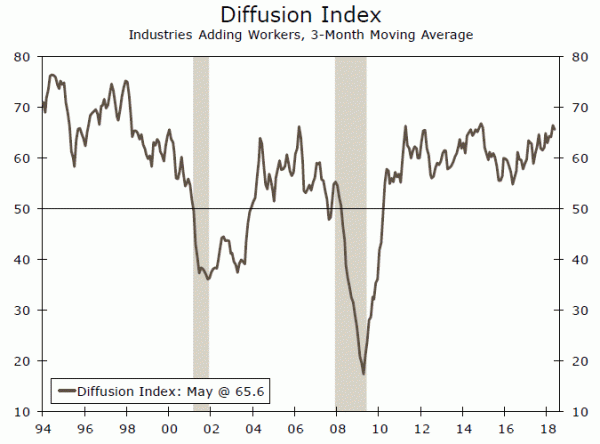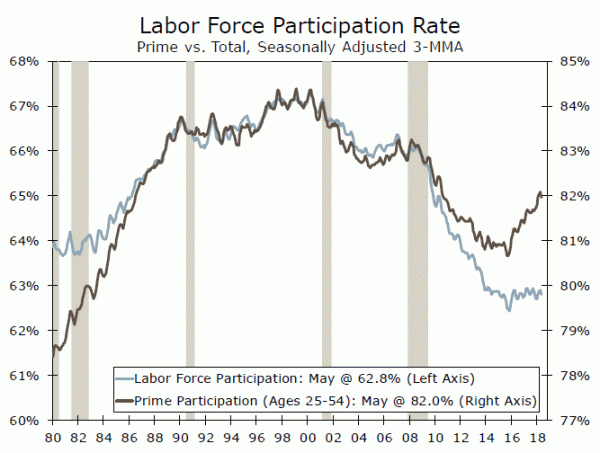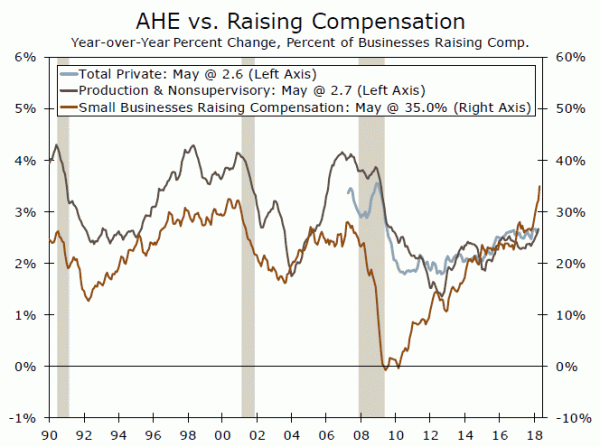Hiring picked up in May, with employers adding 223,0o0 new jobs. Wage growth also improved (+0.3 percent) while unemployment now matches the lowest rate since 1969. The Fed is clear for another hike this month.
From Strength to Strength
Nonfarm payrolls rose by 223,000 in May, above consensus expectations. Over the past six months, job gains have averaged 202,000 per month and continue to indicate no cooling in the trend.
Payroll growth looks increasingly broad across industries. The diffusion index—a measure of the net share of industries adding jobs—improved to 67.6 in May and has been trending up. Notable strength was seen in construction, manufacturing, education & health, professional & business services and retail.
New Cycle Low in Unemployment; Participation Still Concerning
Solid hiring in recent months helped to push the unemployment rate down to 3.8 percent in May. That matches the low of the 1991-2001 expansion. Other indicators of labor market slack also point to an increasingly tight labor market. U-6 unemployment, which includes workers marginally attached to the labor force and part-time workers who want full-time hours, fell to 7.6 percent last month, marking the lowest level since 2001.
With unemployment rates signaling labor has become increasingly scarce, a rebound in labor force participation—particularly prime-age participation— has become all the more important. Although prime participation has recouped significant ground over the past two years, it ticked down for a third straight month in May, and a full recovery from the Great Recession for this group remains some ways off, as structural hurdles like mobility persist.
Wages and Income Improve, Fed Clear for Rate Hike this Month
Rising wages should at least provide a near-term tailwind to luring more workers back into the labor force. Average hourly earnings rose 0.3 percent in May, helped by a 1.4 percent jump in the financial services industry. The year-over-year rate improved to 2.7 percent.
As we have often mentioned, the subdued pace of earnings growth this cycle reflects low productivity growth and inflation. Yet, as cyclical pressures mount and labor becomes increasingly scarce, we expect to see further strengthening in average hourly earnings. Other indicators are also pointing to compensation picking up. The Employment Cost Index was up 2.7 percent year over year through the first quarter, compared to 2.5 percent for 2017, while the share of small businesses raising compensation in May rose to 35 percent—the highest rate in the NFIB survey’s 32-year history.
Factoring in the workers added to payrolls and now earning a paycheck this month, the income proxy—total hours worked multiplied by average hourly earnings—has improved to a 5.4 percent annualized pace over the past three months, compared to 3.3 percent at the start of the year.
Stronger earnings and the continued solid pace of job gains keep the FOMC in the clear for a rate hike later this month despite renewed concerns about the European debt crisis and global trade relations.
















